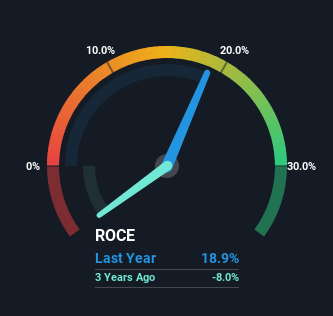- India
- /
- Auto Components
- /
- NSEI:VARROC
Varroc Engineering (NSE:VARROC) Might Have The Makings Of A Multi-Bagger
There are a few key trends to look for if we want to identify the next multi-bagger. One common approach is to try and find a company with returns on capital employed (ROCE) that are increasing, in conjunction with a growing amount of capital employed. This shows us that it's a compounding machine, able to continually reinvest its earnings back into the business and generate higher returns. Speaking of which, we noticed some great changes in Varroc Engineering's (NSE:VARROC) returns on capital, so let's have a look.
Return On Capital Employed (ROCE): What Is It?
Just to clarify if you're unsure, ROCE is a metric for evaluating how much pre-tax income (in percentage terms) a company earns on the capital invested in its business. Analysts use this formula to calculate it for Varroc Engineering:
Return on Capital Employed = Earnings Before Interest and Tax (EBIT) ÷ (Total Assets - Current Liabilities)
0.19 = ₹3.3b ÷ (₹46b - ₹29b) (Based on the trailing twelve months to June 2023).
Therefore, Varroc Engineering has an ROCE of 19%. On its own, that's a standard return, however it's much better than the 14% generated by the Auto Components industry.
See our latest analysis for Varroc Engineering

Above you can see how the current ROCE for Varroc Engineering compares to its prior returns on capital, but there's only so much you can tell from the past. If you'd like to see what analysts are forecasting going forward, you should check out our free report for Varroc Engineering.
What Can We Tell From Varroc Engineering's ROCE Trend?
We're pretty happy with how the ROCE has been trending at Varroc Engineering. We found that the returns on capital employed over the last five years have risen by 26%. The company is now earning ₹0.2 per dollar of capital employed. Interestingly, the business may be becoming more efficient because it's applying 53% less capital than it was five years ago. A business that's shrinking its asset base like this isn't usually typical of a soon to be multi-bagger company.
For the record though, there was a noticeable increase in the company's current liabilities over the period, so we would attribute some of the ROCE growth to that. The current liabilities has increased to 62% of total assets, so the business is now more funded by the likes of its suppliers or short-term creditors. Given it's pretty high ratio, we'd remind investors that having current liabilities at those levels can bring about some risks in certain businesses.
What We Can Learn From Varroc Engineering's ROCE
From what we've seen above, Varroc Engineering has managed to increase it's returns on capital all the while reducing it's capital base. And since the stock has fallen 37% over the last five years, there might be an opportunity here. So researching this company further and determining whether or not these trends will continue seems justified.
If you want to continue researching Varroc Engineering, you might be interested to know about the 1 warning sign that our analysis has discovered.
While Varroc Engineering isn't earning the highest return, check out this free list of companies that are earning high returns on equity with solid balance sheets.
New: Manage All Your Stock Portfolios in One Place
We've created the ultimate portfolio companion for stock investors, and it's free.
• Connect an unlimited number of Portfolios and see your total in one currency
• Be alerted to new Warning Signs or Risks via email or mobile
• Track the Fair Value of your stocks
Have feedback on this article? Concerned about the content? Get in touch with us directly. Alternatively, email editorial-team (at) simplywallst.com.
This article by Simply Wall St is general in nature. We provide commentary based on historical data and analyst forecasts only using an unbiased methodology and our articles are not intended to be financial advice. It does not constitute a recommendation to buy or sell any stock, and does not take account of your objectives, or your financial situation. We aim to bring you long-term focused analysis driven by fundamental data. Note that our analysis may not factor in the latest price-sensitive company announcements or qualitative material. Simply Wall St has no position in any stocks mentioned.
About NSEI:VARROC
Varroc Engineering
Provides aftermarket automotive components and solutions worldwide.
Excellent balance sheet with reasonable growth potential.
Market Insights
Community Narratives


Recently Updated Narratives


MINISO's fair value is projected at 26.69 with an anticipated PE ratio shift of 20x


Fiverr International will transform the freelance industry with AI-powered growth

Constellation Energy Dividends and Growth
Popular Narratives


MicroVision will explode future revenue by 380.37% with a vision towards success


NVDA: Expanding AI Demand Will Drive Major Data Center Investments Through 2026



